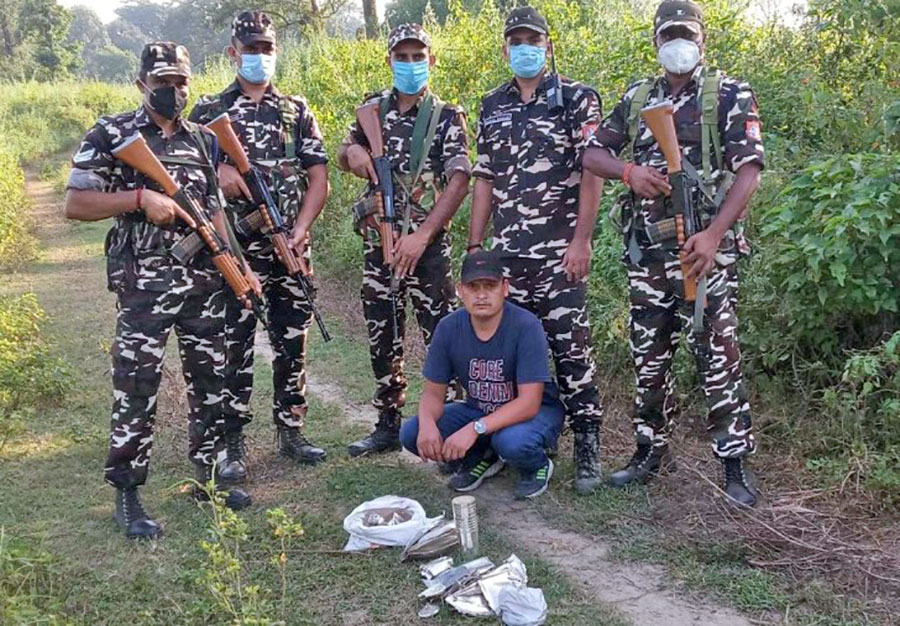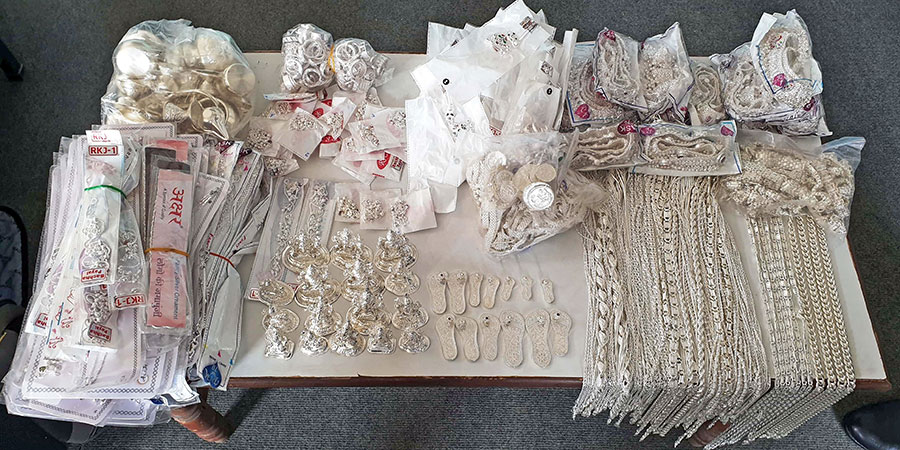In the first three months of the current fiscal year, silver imports in Nepal stood around 126,000 kilograms. In the same period, the Department of Customs says roughly 7,200 kilograms were exported out of the country in the shape of dishes, decorative items and jewelry.
There are only a few people who sell silver in Nepal. They say that, on average, they sell around 200 kg silver a day. Thanks to Covid-19, that number is decreasing every day, says the Federation of Nepal Gold And Silver Dealers Association.
If you take that into consideration, only 18,000 kg should have been consumed in Nepal in the past three months along with the extra 7,200 that was exported. However, what happened to the remaining 101,000 kg silver is a question plaguing everyone.
Silver worth Rs 11.99 billion entered Nepal in the past three months, which is a lot compared to the import in the same period last year (silver worth Rs 495 million). This is 27 times more than what Nepal imported last year as Nepal is importing around 1,400 kg silver every day.
If you do that maths, import, export and consumption of silver in Nepal do not match. But, in the fiscal year 2020/21 also, silver worth Rs 9.88 billion was imported whereas the metal worth Rs 225 million was exported, creating a massive discrepancy.
The Federation says even if they assume that 200 kg silver was consumed every day, it still does not account for around 46,500 kg silver.
“Where did the silver go? It’s a question plaguing everyone,” says the federation’s general secretary Dharma Sundar Bajracharya.
This discrepancy has been almost every year. In the fiscal year 2019/20, Nepal imported 144,000 kg silver while it exported only 3,668 kg of it. A similar case can be seen almost every year, which is puzzling both government officials and the Federation of Nepal Gold and Silver Dealers Association.
They think the answer is that Nepal has turned into a hub for silver smuggling, controlling which requires a lot of effort.
Where does it go?

The Department of Customs only allows decorative items made from silver to be exported as it has banned the export of raw silver altogether. With the books not balancing and silver not being consumed in Nepal, experts believe it is surely a case of silver smuggling.
The Federation of Nepal Gold and Silver Dealers Association and Federation of Handicraft Associations of Nepal say they believe that silver is being embezzled in high quantity. The Federation of Nepal Gold and Silver Dealers Association says it has informed the Finance Ministry and the central bank about the problem of silver smuggling six months ago.
“Silver imports going up makes little to no sense at a time when businesses have suffered so much. The handicraft market is down due to Covid-19 as are sales of ornaments. The government should know who is hoarding or embezzling silvers, but it seems the Finance Ministry and the Nepal Rastra Bank 9the central bank) are accomplices in this,” says an official at the Federation of Nepal Gold and Silver Dealers Association.
The Federation of Handicraft Associations of Nepal says even the banks, who give out letters of credit to buy silver, are at fault along with the central bank and the Finance Ministry.
“We’ve written to the Rastra Bank about the increase in the import of silver. But, they didn’t respond. The more time the government wastes, the worse this situation will get,” says Manik Ratna Shaka, the president of the Federation of Nepal Gold and Silver Dealers Association.
Embezzlement possible: Finance Ministry
The government seems to have accepted that there is something going behind the scene when it comes to the silver trade in Nepal. On October 5, the government amended the customs on silver. After the amendment, the price of silver became more expensive than in India.
“We had to do that as we saw that the import was more than the demand. We want to control that,” says Ritesh Shakya, the spokesperson of the Finance Ministry.
After the decision, customs of 10 gm silver has increased by Rs 22.
The central bank says it realised irregularities in the silver trade in the first month of the current fiscal year. An official at the bank says it has already informed the Finance Ministry about possible silver smuggling and embezzlement after the officials realised that too much silver was being imported.
“The amount of silver brought into the country made no sense. We don’t know since when this has been going on because anyone could import it. We had to control it at one point,” says a customs officer.
The Federation of Nepal Gold and Silver Dealers Association and Federation of Handicraft Associations of Nepal are the only two organisations in Nepal that can trade silver in high quantity. But, anyone can import a small amount.
“We need to make sure that silver trade is made transparent because what’s going on right now is wrong,” says Bajracharya from the Federation of Nepal Gold and Silver Dealers Association.
Silver smuggling across the border

Silver smuggling has been taking place along the border for a few years now. On October 27, Nepal Police caught Dharmendra Sharma from Rutuwamai municipality in Morang with 1.1 kg silver. A month earlier, police also caught Bidya Nanda Sah Sonar from Gaur municipality in Rautahat with 40 kg silver worth nearly Rs 4 million. Police also caught Sonu Kumar Sonar in Parsa with silver ornaments worth Rs 179,000 in August.
Indian police have also been arresting people who have been trying to smuggle silver in and out of the country. On October 16, Indian Sashastrra Seema Bal (SSB) personnel caught a Nepali national from Bajhang who had silver utensils worth in excess of Rs 400,000 from a border point in far-west Nepal.
Organised silver smuggling has also been reported in recent times. On October 6, India’s Directorate of Revenue Intelligence confiscated around 260 kg silver worth Rs 17 million. It believes the silver was brought into India via Nepal.
Investigations needed
In Birgunj, a city in southern Nepal near the Indian border, the only silver that one will find are ornaments and utensils as silver dealers do not produce anything there. Utensils are brought in from Kathmandu while ornaments are brought from Janakpur. Those who are doing this legally have not been facing any problems.
As silver is a decorative item, the private sector is free to import silver by fulfilling due process from a bank. The silver can be sold to any silver firm.
Niraj Sarraf, a former president of the Federation of Nepal Gold and Silver Dealers Association in Parsa, says the government should not start looking into who brought how much silver and how it was used.
“No one can import silver without the help of banks so the government should ask the banks who are the ones who are bringing so much silver and where it is being used. Was it given to a firm or a person these things need to be checked,” says Sarraf. “We need to investigate why a person who can’t even trade silver worth Rs 1 million is bringing in silver worth Rs 2 million. The government has to investigate.”
Some silver traders in Birgunj say that banks, distributors, firms and importers are involved in silver smuggling and illicit trade in Nepal.
“Silver distributors and importers are setting up firms in the name of their families and selling silver as their please. They don’t have a shop. Where does the silver go? My bet is it’s traded illegally to India,” says an official from Federation of Nepal Gold and Silver Dealers Association Parsa.
Federation of Nepal Gold and Silver Dealers Association Parsa’s vice president Shiva Sarraf says a quota needs to be set on the amount of silver that can be imported.
Economist Achyut Wagle says that as these silver are traded illegally, it will have a detrimental affect on Nepal’s foreign exchange reserve.
“Precious metals are like money. The illicit trade will encourage informal economy, increase the number of people not paying taxes and also encourage crime oriented economy,” says Wagle who says people might be gathering silver for money laundering purposes.





















